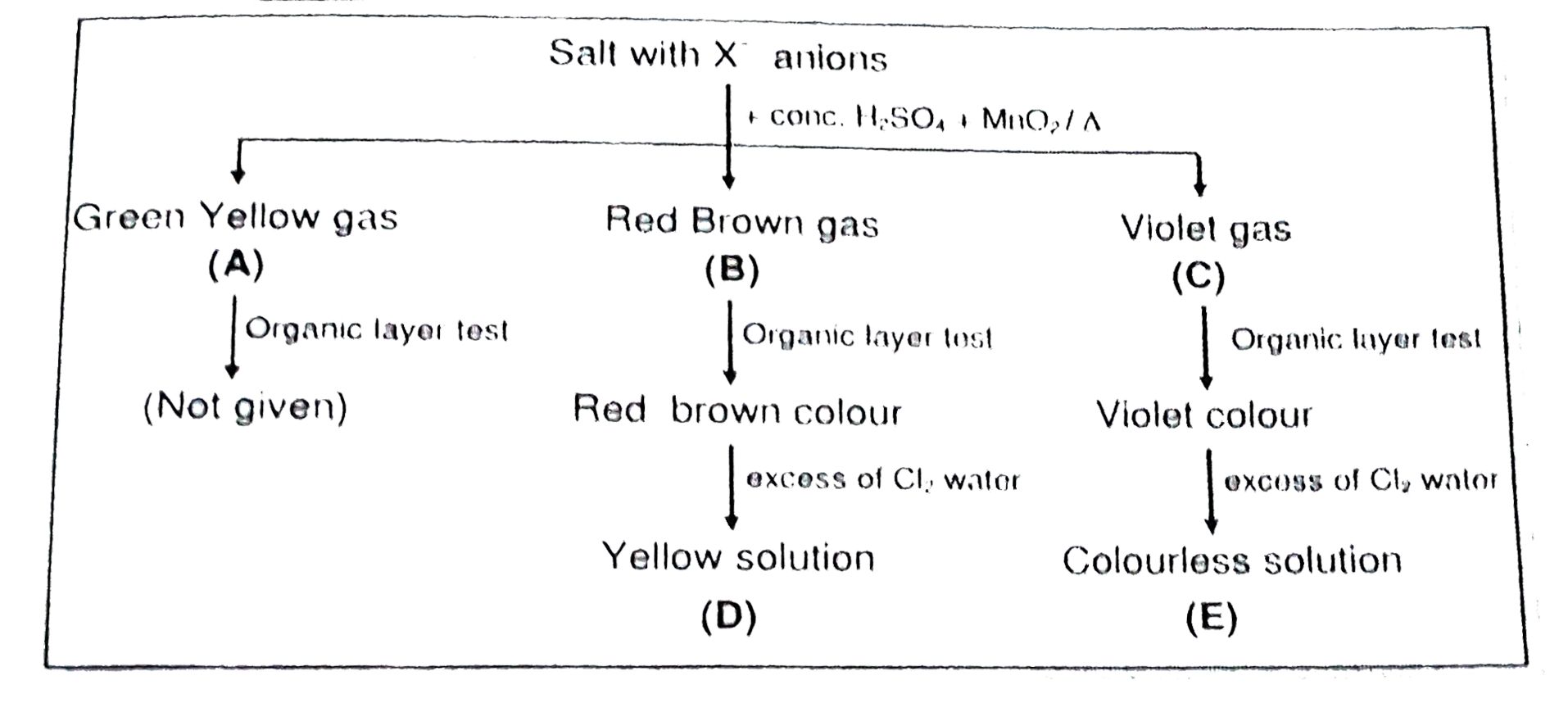H2C2O4△−−→gas(A)+gas(B)+liquid(C). Gas(A) burns with a blue flame and is oxidised to gas(B).
Gas(A)+Cl2→D→NH3,△−−−−→E
A,B,C and E are
CO2,CO,H2O,HCONH2
CO,CO2,COCl2,HCONH2
CO,CO2,H2O,NH2CONH2
CO,CO2,H2O,COCl2
To solve the problem, we need to analyze the decomposition of oxalic acid (H₂C₂O₄) when heated and identify the products A, B, C, and E based on the given information.
1. Decomposition of Oxalic Acid:
- When oxalic acid (H₂C₂O₄) is heated, it decomposes into three products: two gases and one liquid.
- The reaction can be represented as:
H2C2O4Δ−→Gas A+Gas B+Liquid C
2. Identifying Gas A and Gas B:
- It is stated that gas A burns with a blue flame and is oxidized to gas B.
- The gas that burns with a blue flame is carbon monoxide (CO).
- The oxidation of carbon monoxide (CO) produces carbon dioxide (CO₂).
- Therefore, we identify:
- Gas A = Carbon monoxide (CO)
- Gas B = Carbon dioxide (CO₂)
3. Identifying Liquid C:
- The third product formed during the decomposition is water (H₂O).
- Therefore, we identify:
- Liquid C = Water (H₂O)
4. Reaction of Gas A with Chlorine:
- The problem states that gas A (CO) reacts with chlorine (Cl₂) to form product D.
- The reaction is:
CO+Cl2→D
- This reaction produces phosgene (COCl₂), which is a poisonous gas.
- Therefore, we identify:
- Product D = Phosgene (COCl₂)
5. Reaction of D with Ammonia:
- The next step involves treating product D (phosgene) with ammonia (NH₃) to form product E.
- The reaction is:
COCl2+2NH3→E
- This reaction produces urea (NH₂CONH₂).
- Therefore, we identify:
- Product E = Urea (NH₂CONH₂)
Final Identification:
- Gas A = Carbon monoxide (CO)
- Gas B = Carbon dioxide (CO₂)
- Liquid C = Water (H₂O)
- Product E = Urea (NH₂CONH₂)
Summary:
- A = Carbon monoxide (CO)
- B = Carbon dioxide (CO₂)
- C = Water (H₂O)
- E = Urea (NH₂CONH₂)
- When oxalic acid (H₂C₂O₄) is heated, it decomposes into three products: two gases and one liquid.
- The reaction can be represented as:
H2C2O4Δ−→Gas A+Gas B+Liquid C
- It is stated that gas A burns with a blue flame and is oxidized to gas B.
- The gas that burns with a blue flame is carbon monoxide (CO).
- The oxidation of carbon monoxide (CO) produces carbon dioxide (CO₂).
- Therefore, we identify:
- Gas A = Carbon monoxide (CO)
- Gas B = Carbon dioxide (CO₂)
- The third product formed during the decomposition is water (H₂O).
- Therefore, we identify:
- Liquid C = Water (H₂O)
- The problem states that gas A (CO) reacts with chlorine (Cl₂) to form product D.
- The reaction is:
CO+Cl2→D
- This reaction produces phosgene (COCl₂), which is a poisonous gas.
- Therefore, we identify:
- Product D = Phosgene (COCl₂)
- The next step involves treating product D (phosgene) with ammonia (NH₃) to form product E.
- The reaction is:
COCl2+2NH3→E
- This reaction produces urea (NH₂CONH₂).
- Therefore, we identify:
- Product E = Urea (NH₂CONH₂)
- Gas A = Carbon monoxide (CO)
- Gas B = Carbon dioxide (CO₂)
- Liquid C = Water (H₂O)
- Product E = Urea (NH₂CONH₂)
- A = Carbon monoxide (CO)
- B = Carbon dioxide (CO₂)
- C = Water (H₂O)
- E = Urea (NH₂CONH₂)
Topper's Solved these Questions
- p-BLOCK ELEMENTS-1BOOK - VMC MODULES ENGLISHCHAPTER - p-BLOCK ELEMENTS-1EXERCISE - JEE Main Archive
34 Videos
- p-BLOCK ELEMENTS-1BOOK - VMC MODULES ENGLISHCHAPTER - p-BLOCK ELEMENTS-1EXERCISE - JEE Advanced Archive
48 Videos
- p-BLOCK ELEMENTS-1BOOK - VMC MODULES ENGLISHCHAPTER - p-BLOCK ELEMENTS-1EXERCISE - LEVEL 1
75 Videos
- MOCK TEST 9BOOK - VMC MODULES ENGLISHCHAPTER - MOCK TEST 9EXERCISE - CHEMISTRY (SECTION 2)
5 Videos
- PERIODIC PROPERTIES OF ELEMENTSBOOK - VMC MODULES ENGLISHCHAPTER - PERIODIC PROPERTIES OF ELEMENTSEXERCISE - IMPECCABLE
50 Videos
Similar Questions
H2C2O4△−−→gas(A)+gas(B)+liquid(C). Gas(A) burns with a blue flame and is oxidised to gas(B).
Gas(A)+Cl2→D→NH3,△−−−−→E
A,B,C,D and E are
View SolutionH2C2O4Δ−−→ gas (A)+gas(B)+liquid(C) oxalic acid Gas (A) burns with blue flame and is oxidised to gas (B). Gas (B) turns lime water milky
Gas (A)+Cl2→(D)NH3.Δ−−−−→(E)NH3.ΔB
Identify (A) to (E) and explain reactions involved.
View SolutionSalt + conc. H2SO4+ Ethyl alcohol Δ−−→ Gas. Evolving gas (vapours) burns with green edged flame acidic radical may be.
View SolutionMatch the following
Column I Column II(A) FeSO4Δ−−→(p) A gas which gives green colour with acidified K2Cr2O7(B) NaNO2dilHCl−−−→Aair−−→B (gas)(q) A gas which form oleum with H2SO4(C) Na2SO3dil(HCl)−−−−−→P (gas)(r) A gas which is mixed anhydride of HNO2andNHO3(D) NaClconc.H2SO4−−−−−−−→P (gas)(s) A gas which is also given by AlCl3 in moist air(t) Green colour
View Solution
Identify the gas A, B and C.
View SolutionA+dil.H2SO4Δ−−→gas(B). Gas(B) turns K2Cr2O7/H solution green.
Aq. solution of A+BaCl2→Whiteppt.(C)Filtrate after removing (C) + Br_(2) water ⟶whiteppt(C). Here (A), (B) and (C) are
Identify(A),(B) and(C).
View Solutiona.(A) +KBr→ yellow ppt . (B)
(A) +conc.H2SO4Δ−−→ brown vapours intensifield with cu- turnings.
(B) dissolves in lypo forming a soluble complex (C ) what are (A),(B) and (C ) and explain their reactions ?
b. SO2−3 and SO2−4 both give while ppt with BaCI2 solution .How is SO2−3 detected in presence of SO2−4?
c. Na2B4O7.10H2O+conc.H2SO4Δ−−→(A)CH2OHΔ−−−−−→(B) idenity (A) and (B)
d. (A) +diiH2SO4Δ−−→gas(B)
Gas (B) turns K2Cr2O7/HΘ solution green Aq solution of (A) +BaCI2→ while ppt .(C )
Filltrate after removing (C) +Br2 water rarr while ppt dissolve in qammon ium acetate solution Example.
View Solution(NH4)2Cr2O7 on heating liberates a gas. The same gas will be obtained by
View Solution(NH4)2Cr2O7 on heating liberates a gas. The same gas will be obtained by
View SolutionLi+N2Δ−−→AH2O−−→B+(C) gas
Then the correctly matched pair for A,B,C are :
View Solution
